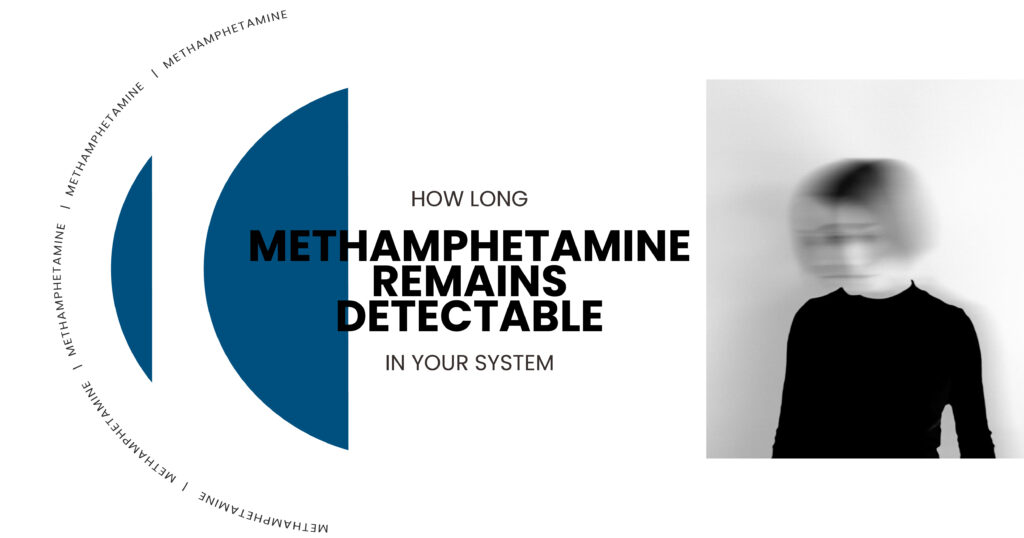How Long Does Methamphetamine Remain Detectable in Your System?

Authored By:
Raleigh Souther

Edited By:
Chase Mcquown

Medically Reviewed By:
Dr. Alejandro Alva
- Last Updated:

Understanding how long methamphetamine stays in your system is essential for anyone concerned about drug testing, recovery, or overall health. Methamphetamine, a powerful central nervous system stimulant, is a drug that influences the brain and the body of a person who takes it often. The lingering effect of the drug in your system is determined by several factors, including modes of use, dosage, metabolism rate, and the type of drug test used.
Because methamphetamine may have a devastating effect on the mental and physical health of an individual, knowledge of the time of detection and testing is crucial for the person seeking help with treatment or building their lives using support programs such as Visalia Recovery Center.
Urine Drug Testing: Procedure and Detection Time Explained
A urine drug test is one of the most popular techniques for detecting the use of methamphetamine. This is a popular technique because it is convenient, highly accurate, and has a reasonably long aperture of detection in comparison to other methods of testing. When the meth gets into the bloodstream, it is quickly metabolized by the liver to a metabolite and is excreted.
Methamphetamine can be identified in urine 1 to 4 days after use on average, but in severe or chronic use, it can extend to as long as a week. The duration can be influenced by factors like hydration, the level of pH, and the frequency of usage.
The tests of urine are usually done through immunoassay screening and then confirmed through gas chromatography-mass spectrometry (GC-MS). This two-step process is accurate and reduces false positives or false alarms, which can occur due to over-the-counter medications or other stimulants such as pseudoephedrine.
University of Rochester Medical Center (URMC) explains that amphetamines (including methamphetamine) can show up in urine for about 1 to 3 days after use.
Blood Drug Testing: How It Works and What It Detects
Blood drug testing is the most effective way to detect active methamphetamine in the body. It is used to determine the precise quantity of the substance in your blood and is therefore very useful when determining the level of intoxication or recent usage. The average duration of methamphetamine to be detected in blood is 24 to 48 hours after use.
In the case of chronic users, however, it can take longer because the drug tends to be stored. In less frequent situations, blood testing is applied to screen workers in the workplace because it is invasive and has a shorter detection limit, although it is commonly applied in medical emergencies or legal investigation scenarios where the accuracy is paramount.
The sensitivity of the blood testing can be used to give a thorough understanding of the current status of the user, and therefore it can be very useful to the clinicians who need to follow the progress of the detoxification or withdrawal treatment.
Saliva Drug Testing: Advantages, Accuracy, and Detection Windows
Oral fluid testing or saliva testing is a non-invasive and rapid method of identifying the recent use of methamphetamine. Its ease of collection is what makes it suitable for roadside screening or other workplaces where urgent outcomes are required.
Methamphetamine is normally found in saliva up to 48 hours after last use. Detection can, however, differ depending on how much time has elapsed since consumption of the drug and the oral hygiene of the user.
Saliva tests concentrate on the use but not the history, as the urine or hair tests would. They are advantageous because of their quick outcomes and fewer possibilities of being tampered with. For readers interested in understanding more about saliva testing science, check out the educational resource by the National Institute on Drug Abuse (NIDA).
Hair Drug Testing: Duration of Detection and Metabolism Insights
Hair drug testing has the longest detection window compared to all other modes of testing. Once methamphetamine is put into the bloodstream, minute traces will find their way to the hair follicles, where they may be trapped for up to 90 days or more. This is the best technique for identifying chronic or habitual use, since hair will test out a history of the previous exposure. One and a half inches of hair is a typical sample of this kind – it signifies three months of drug history.
Nevertheless, this type of testing is not foolproof. Contact with users or outside contamination by smoke can occasionally result in trace contamination, and this is minimized by the current washing procedures. Hair tests are more usually applied in the law or professional aspects, where behavior over a long time must be evaluated.
Understanding Half-Life and Its Role in Drug Testing Results
Methamphetamine has a half-life of 10–12 hours, which is the period during which 50 percent of the drug is metabolized and expelled. This implies that once the half-life is complete, half of the substance will still be active in the blood. The half-life influences performance in the different tests as follows:

| Testing Method | Average Detection Time | Relation to Half-Life |
| Urine | 1–4 days | Reflects metabolites after several half-lives |
| Blood | 24–48 hours | Detects active drug before most is metabolized |
| Saliva | Up to 48 hours | Correlates closely with immediate presence |
| Hair | Up to 90 days | Independent of half-life; records long-term exposure |
The concept will help one understand the reason some tests are capable of detecting meth even after the impacts have passed. In the process of recovery, it is often useful to learn about the role of metabolism in their outcomes so as to reduce anxiety and foster transparency in the treatment process.
Factors Influencing Metabolism and Detection in Drug Tests
A number of these factors determine the amount of time that methamphetamine remains in your system. These are biological, lifestyle, and environmental variables that influence the body’s efficiency in processing the drug. Key factors include:
- Age And Health. Older individuals or those with liver and kidney issues metabolize meth more slowly.
- Frequency And Dosage. Higher doses and repeated use extend detection time.
- Body Composition. Meth tends to accumulate in fatty tissues, prolonging elimination.
- Hydration and pH. Acidic urine can speed up methamphetamine excretion.
- Genetic Metabolism Rate. Some people naturally process substances faster than others.
These elements make detection highly individualized—what may disappear from one person’s system in two days could linger for a week in another.
Comparing Drug Testing Methods: Pros, Cons, and Use Cases
All the drug testing approaches have advantages and disadvantages. Below is a comparison to assist you in the understanding of what test could be applied and why:
| Test Type | Pros | Cons |
| Urine Test | Inexpensive, reliable, widely used | Can be adulterated or diluted |
| Blood Test | Accurate, detects active drug | Invasive, short detection window |
| Saliva Test | Quick results, hard to tamper with | Short detection time |
| Hair Test | Long detection window, non-invasive | Expensive, may show old use |
Ultimately, the right test depends on the purpose—whether it’s employment screening, clinical evaluation, or recovery monitoring.
How to Prepare for a Drug Test and What to Expect
Drug testing preparation is not just about physical preparation, but also about understanding how it works. You might be required to give a urine sample, hair strand, saliva swab, or blood draw, depending on the type of test that is to be done.
The following are some recommendations to make you vigilant and prepared to take the test:
- Keep hydrated, but not too much – excessive water may dilute samples.
- Do not use drugs that can be confused with the examination without informing your provider.
- Report the truth to the administrator of the test in case you are under treatment or recovery.
- Get professional help, such as that of a recovery center, which would guide you on how to handle anxiety or related issues.
Legal and Workplace Implications of Drug Testing Results
A failed drug test can have dire legal/professional implications, such as loss of employment, suspension of a license, or imprisonment. The federal regulations are adhered to by many organizations, particularly in safety-sensitive jobs. In the case of people in recovery, transparency and early help-seeking can help alleviate most of these problems. Legal counsel and recovery facilities may provide you with help in dealing with the results of the tests and how to proceed with your future.
Get Expert Guidance and Support with Visalia Recovery Center Today
We offer science-based, caring treatment that is based on your needs, in case you or one of your loved ones is having a hard time using methamphetamine. Visalia Recovery Center can help you. The physical and psychological side of the addiction is also covered by their programs, making people detoxify without harm to their bodies and restructure their lives. Call Visalia Recovery Center today to meet a recovery specialist and start living a healthier life. It is not too late to heal – but with the right assistance.

FAQs
How long can methamphetamine be detected in a urine drug test?
The drug is likely to exist in urine between 1 and 4 days after consumption. Slower rates of elimination may result in positive results in cases of heavy or chronic users, as long as one week.
What is the detection time for methamphetamine in a blood test?
Methamphetamine can be detected in blood (24–48 hours post-use). However, chronic users can hold detectable levels slightly longer with dosage and metabolism.
How effective is saliva testing in detecting methamphetamine use?
Saliva tests are quite effective for recent use, detecting meth for up to 48 hours post-consumption. They’re commonly used for roadside or workplace testing because results are fast and reliable.
Can hair drug tests reveal long-term methamphetamine use, and how does metabolism affect this?
Yes, hair tests can detect the use of meth for up to 90 days and above. There is little influence of metabolism because the drug will be integrated into hair follicles as it grows.
What role does the half-life of methamphetamine play in drug test detection times?
The body elimination rate of methamphetamine is determined by its half-life, which ranges between 10 and 12 hours. It has a direct impact on the detection windows of various testing methods.

